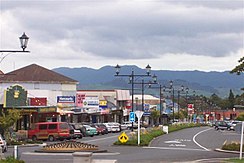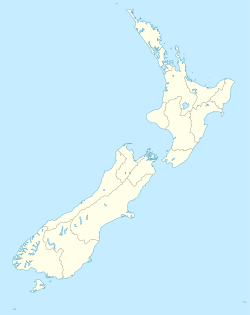Waihi
| Waihi | ||
| Geographical location | ||
|
|
||
| Coordinates | 37 ° 23 ′ S , 175 ° 50 ′ E | |
| Region ISO | NZ-WKO | |
| Country |
|
|
| region | Waikato | |
| District | Hauraki District | |
| Ward | Waihi Ward | |
| Residents | 4th 527 (2013) | |
| height | 109 m | |
| Post Code | 3610 | |
| Telephone code | +64 (0) 6 | |
| UN / LOCODE | NZ WHI | |
| website | www.waihi.org.nz | |
| Photography of the place | ||
 View over the main street from Waihi to the south |
||
Waihi is a small town in the Hauraki District of the Bay of Plenty region on the North Island of New Zealand , which was largely shaped by gold mining.
Origin of name
The name of the place means something like "flowing water" in the Māori language .
geography
The city is located around 38 km southeast of Thames and around 43 km northwest of Tauranga at the southern end of the Coromandel Range . The Kaimai Range begins southwest of the city and extends to the northwest of Lake Rotorua . About 10 km east of the city is the tourist and holiday resort of Waihi Beach , which is the westernmost point of the Bay of Plenty .
history
Gold rush and mining
The entire region was once one of the most important gold mining areas on earth. Numerous gold discoveries caused a strong population increase in the 1870s. The urban area of Waihi also developed rapidly after the first gold was found on Pukewa Hill , later called Martha Hill , in 1878 by gold prospectors John McCombie and Robert Lee . But the two gold seekers lacked the capital to finance the facilities that were necessary to separate the gold and silver found from the quartz rock. So they finally gave up on their project. In 1881 the Martha Extended Company took over the rights to the mining area and the chairman of the company, William Nicholl named the mine " Martha Mine " after his wife. The mine was later owned by the Waihi Gold Mining Comany , based in London . In 1905 Waihi already had around 6,000 inhabitants and in 1909 gold was mined to the value of 1 million pounds .
At the beginning of the 20th century, Waihi was the center of trade union unrest in New Zealand. The Waihi miners' strike in 1912 with violent riots and one death is still causing bad memories in the city today. The labor dispute, in which the strikers were initially defeated and dismissed, is considered to be the beginning of the New Zealand labor movement in New Zealand.
The Martha Mine was closed in 1952 and by then had delivered around 174,160 kilograms of gold and 1,193,180 kilograms of silver from over 11.932 million tons of ore. The gold deposits were not yet exhausted, but given the gold price at the time, the completely outdated plants could no longer be operated profitably. With the end of mining, Waihi initially lost its economic basis and the number of inhabitants fell significantly as a result.
In 1961 part of the old mine collapsed west of the Cornish Pumphouse and created a crater around 40 meters in diameter.
Temporary post-mining age
In the 1970s, Waihi was very popular with people from the hippie and alternative scene who settled in the city. As a result, the construction industry also experienced a certain boom, which in turn gave Waihi s economy a revival. The big Nambassa rock and alternative music festivals between 1976 and 1981 took place around Waihi and Waikino and were popular with tens of thousands of fans of the music and "live styles" wave from New Zealand and overseas. Tent cities were built to accommodate guests at the north end of Waihi on numerous farms along Landlyst Road in the Golden Valley , and the population of Waihi grew by 10,000 to 75,000 people during the Nambassa Festival. The festivals brought much-needed capital into the city.
Revival of gold mining
After years of preparation and geological investigations, the new Waihi Gold Mining Company was finally founded on July 18, 1987 with the aim of reopening the Martha Mine . With new mining technologies and rising world market prices for gold and silver, precious metal mining now had a secure medium-term perspective. The mine officially went back into production on June 15, 1988. For this purpose, the gold-bearing rock was transported out of the open pit mine on conveyor belts to a processing plant 2.7 km away, where the gold was separated from the rock.
In February 1999, part of the mine collapsed again and, for a reason similar to that in 1961, created a crater around 40 meters in diameter. The damage to the mine caused by landslides did not stop. In December 2001, a house near the opencast mine slid into the abyss and in April 2015 and April 2016, large parts of the slopes went into the over 600-meter-deep abyss twice, most recently 2 million cubic meters of rock, so that it can be assumed that the mine must be abandoned because of instability.
In June 2004, the operating company of the mine was renamed Newmont Waihi Gold Limited and the mine was finally sold to OceanaGold Gold with effect from June 1, 2016 .
population
In the 2013 census, the town had 4,527 inhabitants, 0.6% more than in the 2006 census.
economy
Gold mining has long been considered one of the city's largest employers, but this has become increasingly uncertain since the people left the mine. Waihi is the service center in the surrounding area, which prefers to make a living from dairy farming, sheep and cattle breeding, and vegetable and fruit growing. Some industrial plants are also in the city. Waihi has done a lot for tourism, which is increasingly benefiting from the growth in the number of vacationers on the Coromandel Peninsula and its proximity to the Bay of Plenty . In the 1980s, part of the former East Coast Main Trunk Line was revived as a museum train by the Goldfields Steam Train Society , an association of rail enthusiasts. The Goldfield Railway Inc. operates today between Waihi and Waikino .
Infrastructure
Road traffic
The New Zealand State Highway 2 runs through Waihi and connects the city with Paeroa in the west and Katikati in the south. Within the city, the New Zealand State Highway 25 branches off north to Whangamata .
Rail transport
Waihi was also connected to the New Zealand rail network from 1905 to 1979 via the East Coast Main Trunk Railway .
Air traffic
The nearest airport is in Tauranga .
See also
literature
- Helga Neubauer: Waihi . In: The New Zealand Book . 1st edition. NZ Visitor Publications , Nelson 2003, ISBN 1-877339-00-8 , pp. 249-251 .
Web links
- Homepage . Waihi,accessed June 18, 2014.
- Homepage . Ozeana Gold,accessed October 22, 2017.
- Homepage . Goldfields Railway,accessed June 18, 2014.
Individual evidence
- ↑ a b 2013 Census QuickStats about a place : Waihi . Statistics New Zealand , accessed June 18, 2014 .
- ^ Neubauer: Waihi . In: The New Zealand Book . 2003, p. 251 .
- ↑ a b Topo250 maps . Land Information New Zealand , accessed October 22, 2017 .
- ↑ a b c Neubauer: Waihi . In: The New Zealand Book . 2003, p. 250 .
- ↑ The original Martha Mine . Oceana Gold , accessed October 22, 2017 .
- ^ The early Martha Mine . Oceana Gold , accessed October 22, 2017 .
- ↑ a b The modern Martha Mine . Oceana Gold , accessed October 22, 2017 .
- ↑ Waihi collapse victims get $ 1.6m compensation . In: New Zealand Herald . NZME. Publishing , January 17, 2002, accessed October 22, 2017 .
- ↑ Elton Rikihanna Smallman : Martha Mine has major rockfall but mayor says there is no risk to public . In: Stuff Buisiness day . Faifax Media , April 26, 2016, accessed October 22, 2017 .
- ^ Neubauer: Waihi . In: The New Zealand Book . 2003, p. 249 .


